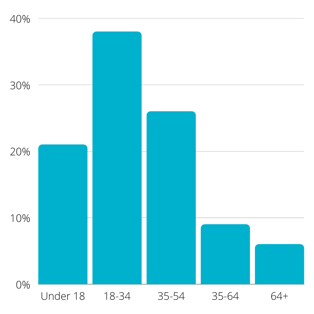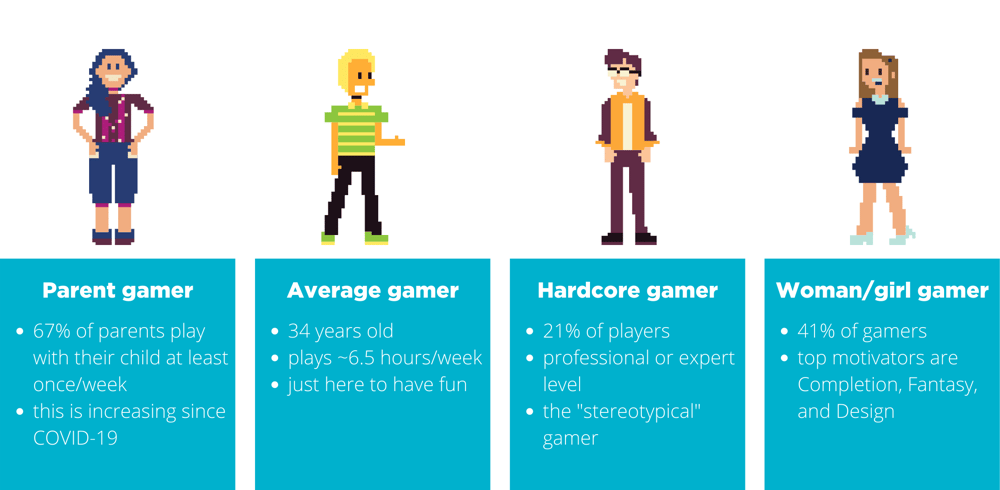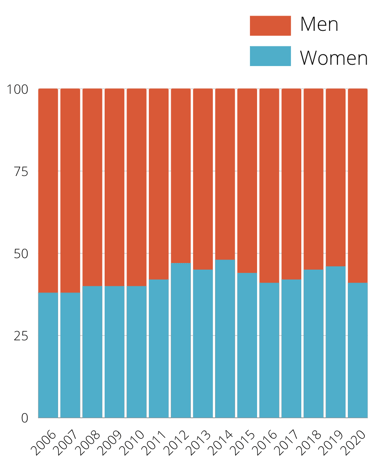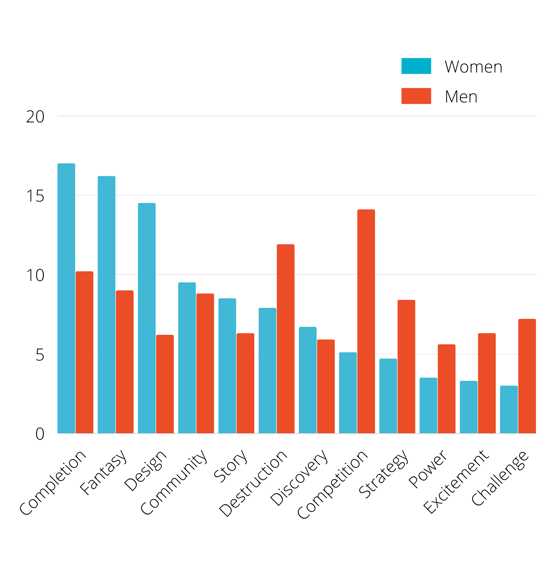What you need to understand about women in gaming
The gaming industry may be thriving, but it can still do better. To continue their unprecedented growth, companies must find new sources of revenue, create partnerships and seek out innovative ways to make the gaming experience more inclusive for everybody – especially women. With 41% of US gamers identifying as female, research shows that despite their high adoption rates this segment isn’t reaching its revenue potential.1
Who are gamers? Not who you think they are
 Long gone are the days when the typical gamer was seen as an introvert logging 10 hours a night in their basement. Today, there are entirely new segments of gamers that did not exist even five years ago. There are fanatics, enthusiasts, dabblers and even people who play a lot but would never self-identify as a gamer. Yes, Millennials and Gen Zs dominate the space, but statistics outside of age demographics are far less homogenous.
Long gone are the days when the typical gamer was seen as an introvert logging 10 hours a night in their basement. Today, there are entirely new segments of gamers that did not exist even five years ago. There are fanatics, enthusiasts, dabblers and even people who play a lot but would never self-identify as a gamer. Yes, Millennials and Gen Zs dominate the space, but statistics outside of age demographics are far less homogenous.
In order to activate the most effective marketing strategies, companies need to tap into new audience segments rather than relying on old stereotypes.
So who are today’s gamers?

The Parent Gamer
More and more parents are taking an active interest in their children’s gaming habits, with 67% reporting that they play video games with their child at least once a week. Additionally, 30% of teen gamers report that their parents are showing more interest in their online lives since COVID-19 began.2
The Average Gamer
Some people may find it surprising that the average gamer is 34 years old and only plays a little over six hours a week.3 This demographic is likely to be busy with other priorities, such as work, family, or friends and uses gaming as a way to pass time or wind down after a hard day.
The Hardcore Gamer
21% of players identify as hardcore gamers, which is defined as someone who plays very seriously or even competitively with high-end equipment and is logging serious hours.1 This is what people usually think of as the “stereotypical gamer.”
The Woman/Girl Gamer
Female gamers make up nearly half of the gaming market. If you break this down further, women aged 18-35 comprise 30% of all gamers in the US.4
Now that we understand a bit more about who’s picking up a controller or logging in online, it’s time we ask ourselves what the current gaming habits and patterns are of women and girls in this space.
Let’s take a closer look at female gamers

With the recent explosion of popularity in gaming during the pandemic, you’d naturally expect the number of women who game to have also skyrocketed. After all, gaming is a space we should all be able to enjoy, right? The data suggests otherwise.
Over the past decade, the total number of players who identify as female has increased ever so slightly. In 2006, 38% of players identified as women. In 2020, it’s 41%.5 Creating content targeted for nearly half of your potential audience seems like an obvious cheat-code for increased revenue. Yet, the industry has struggled to convince women that they’re a truly valued audience.
To build up their base without alienating their core, gaming companies need to do more than develop great content, they need to create experiences that resonate with gamers regardless of their gender. In other words, they need a much better understanding of who is playing (or not playing) and why.
The majority of women are playing for a few key reasons
One of the primary reasons that gaming companies are struggling to capitalize on their female fans is that they’re sticking to a core set of motivators.6
When asked which motivators they’re looking for, women selected Completion (17.0%), Fantasy (16.2%) and Design-based games (14.5%) as their top three choices. In comparison, men chose Competition (14.1%), Destruction (11.9%), and Completion (10.2%).
 Looking at these statistics, you’ll notice that men’s preferences across the different categories are generally more balanced. When you add the totals for the three most popular gaming motivators for men, this accounts for just over a third of the male gamer population (36.2%). In contrast, when you do the same with the top three motivators for women this covers nearly half (47.7%).
Looking at these statistics, you’ll notice that men’s preferences across the different categories are generally more balanced. When you add the totals for the three most popular gaming motivators for men, this accounts for just over a third of the male gamer population (36.2%). In contrast, when you do the same with the top three motivators for women this covers nearly half (47.7%).
It’s a toxic environment
It’s hard to create inclusive spaces when current research reveals only part of the picture. To create an environment where women feel welcome, we need to hear the full story from women themselves. Some of the main biases holding women and girls from playing more are:
👉 Social stigma- only 6% of women report that they consider themselves a gamer7
👉 Online harassment- 36% of women report feeling like they’re treated with less respect than men while gaming8
👉 Lack of representation- Only 18% of games offer a female protagonist9
👉 Sexist female characters- The majority of female characters are portrayed as submissive or are hyper-sexualized10
#gamergate is a perfect example of this
In 2014, an online harassment campaign, known as Gamergate, centered around sexism and anti-progressivism in videogame culture, and ended in death threats to multiple female game developers and a journalist.11
How has gaming industry the responded?
Aside from the standard PR acknowledging that they do not condone sexism or bullying, companies, for the most part have side stepped the issue and instead focused on strategies that on the surface appear more inclusive without addressing the core issues.
There are still significant barriers to adoption that companies need to overcome.
The market opportunity for women in gaming is massive, however it’s important to understand that it isn’t a “make it and they will play” situation. Gaming companies that connect with women in an authentic way with open, meaningful dialogue will be rewarded with even greater revenue.
Here’s a look at what the industry is doingWhile profitable and undoubtedly popular, these tactics have still failed to capitalize on the market opportunity of female gamers |
Turning these lessons into action
While there is an abundance of data in the gaming space, it does not provide actionable insights into why females play. In order to truly understand the attitude, opinions and unique preferences of these gamers, companies need to rethink the way they engage this key audience:
Here’s five things to consider for companies who truly want to understand their female gamers:
👉 Make your surveys and focus groups a natural extension of your brand or the gaming experience
👉 Add video testimonials to bring quantitative data to life
👉 Engage Gen Zs and Millennials on channels that they’re already familiar with like text (SMS) and social media
👉 Create a space for candid feedback where you can use the insights to drive future business decisions
👉 Structure your market research strategy so that you’re receiving in-the-moment feedback for time-sensitive events or releases
Final Thoughts
Women gamers are a largely untapped market with unmeasurable revenue potential. While they make up 41% of the gaming population, we know that this percentage is not translating into increased revenues. Gaming companies have the opportunity to connect with an audience segment positioned to transform the next decade of gaming trends. The companies that get this right—from engagement and understanding to genuinely inclusive and exciting experiences—are going to dominate.
Sources
1. https://techjury.net/blog/video-game-demographics/#gref
2. https://venturebeat.com/2020/06/29/roblox-how-teens-are-using-games-to-cope-with-the-pandemic/#:~:text=Teenagers%20who%20use%20the%20virtual,a%20survey%20by%20the%20company.&text=Roblox%20found%20that%2052%25%20of,chat%20programs%20during%20the%20pandemic
3. https://www.limelight.com/resources/white-paper/state-of-online-gaming-2020/#:~:text=Video%20gamers%20spend%20an%20average,than%2012%20hours%20a%20week
4. https://mediakix.com/blog/female-gamer-statistics-demographics/#:~:text=Regardless%20of%20gender%2C%20young%20people,30%20were%20video%20game%20players
5. https://www.statista.com/statistics/232383/gender-split-of-us-computer-and-video-gamers/
6. https://quanticfoundry.com/2016/12/15/primary-motivations/
7. https://www.pewresearch.org/internet/2015/12/15/gaming-and-gamers/
8. https://www.washingtonpost.com/graphics/2019/sports/toxic-online-culture-women-esports/#:~:text=A%202017%20Washington%20Post%2DUMass,they%20are%20treated%20about%20equally.
9. https://www.statista.com/statistics/871912/character-gender-share-video-games/
10. https://gcml.org/miss-leading-characters-the-hyper-sexualization-of-females-in-video-games/
11. https://en.wikipedia.org/wiki/Gamergate_controversy
12. https://www.reach3insights.com/blog/fortnite-deadpool-brand-collaboration
13. https://www.reach3insights.com/blog/video-games-perception-time
14. https://www.reach3insights.com/blog/how-retailers-can-take-advantage-of-the-fortnite-phenomenon


